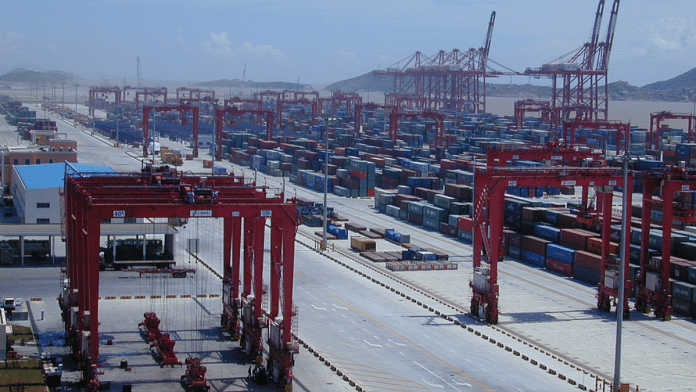New Delhi: China’s exports in 2023 contracted by 4.6 percent to $3.38 trillion from $3.59 trillion in 2022, data released Friday by the General Administration of Customs — China’s customs office — showed. This is the first time its exports have declined in seven years.
China’s total imports for the year fell by 5.5 percent from 2022 to $2.5 trillion in 2023. In 2022, the total value of imports stood at $2.7 trillion, the report said.
The data comes a mere couple of weeks after Chinese President Xi Jinping admitted on New Year’s eve that headwinds are facing the Chinese economy — unemployment and an economic slowdown.
As ThePrint reported earlier, the quarter of July-September 2023 saw its first foreign direct investment (FDI) deficit and fears of domestic capital flight, by Chinese households and private investors – all pointing to an economy facing a myriad of challenges.
In June 2023, China witnessed a record 21.3 percent youth unemployment rate. The year also saw Beijing grapple with a crisis in the real estate market and strain on local government finances and now faces the spectre of falling global demand for goods.
The half-decade between 2020-24 is on record to be the weakest in 30 years, according to the World Bank’s Global Economic Prospect report released Tuesday.
Chinese exports to the US, the European Union, ASEAN countries, and Japan all declined in 2023. The steepest decline was seen in Chinese exports to the US, which fell by 13.1 percent in 2023 in comparison to 2022.
In 2022, China’s total value of exports to the US stood at $581.7 billion, while in 2023 it stood at $500.2 billion, according to China customs.
Beijing’s exports to Germany declined by 13 percent similarly to $100.5 billion in 2023 from $116.2 billion in 2022 while its overall exports to the ASEAN (Association of Southeast Nations) fell by 5 percent in 2023 to $523.67 billion from $567.28 billion in 2022.
ASEAN is a regional grouping that aims to promote economic and security cooperation among its 10 members — Brunei, Cambodia, Indonesia, Laos, Malaysia, Myanmar, the Philippines, Singapore, Thailand, and Vietnam.
In contrast, Chinese exports to Russia grew by 46.9 percent — the highest export growth in the year. In 2022, total exports to Russia stood at $76.1 billion, which grew to $110.97 billion in 2023. Chinese exports to India between January and December 2023 grew by 0.8 percent.
Also Read: India’s trade deficit with China is so far lower in 2023 than last year. Here’s why
2023 — the year of ‘de-risking’ from China
As ThePrint reported earlier, 2023 witnessed momentum for “de-risking” and “supply chain resilience” grow – as a result of shortages during the COVID-19 pandemic and the weaponisation of trade by Beijing.
On 1 July 2023, the Chinese government enacted a law on foreign relations giving it legal backing to take restrictive trade measures in the interests of national security, sovereignty, and domestic interests.
China has a monopoly over rare earth elements (REEs) — a group of 15 elements in the periodic table known as the Lanthanide series that are crucial to emerging technologies, with civil and military applications. It has also been known to weaponise its leverage to coerce a specific outcome.
For example in 2010, after Japan detained the captain of a Chinese fishing trawler after a collision with Japanese coast guard ships when he was trying to fish in waters that are controlled by Japan but claimed by China, according to a report in The New York Times on 10 September, 2010. In retaliation, the Chinese government blocked the exports of REEs — imperative for the production of “hybrid vehicles, wind turbines and guided missiles”, the report said.
The last year also witnessed the escalation of a trade war between Washington D.C. and Beijing, leading to further efforts by the US to friendshoring supply chains – that is, keeping supply chains with allies or partner countries.
According to a report by Nikkei Asia, US’ efforts in friendshoring supply chains has led to China’s slice of the US import market fall to its lowest since 2004 to 13.9 per cent between January and November 2023.
The World Bank, in its latest assessment of the global economy, also highlighted that China in 2024 will see a further slowdown in growth, forecasting a 4.5 percent growth in its gross domestic product (GDP) for the year. For 2023, the World Bank has estimated that China will grow by 5.2 percent.
In its latest assessment released Tuesday, the World Bank revised its estimates of the growth of the Chinese economy in 2023 from 5.6 percent to 5.2 percent, while also reducing its 2024 forecast by 0.1 percent to 4.5 percent in 2024.
(Edited by Uttara Ramaswamy)
Also Read: Despite booming trade, US-China relationship evolving into an ‘ideological rivalry’



